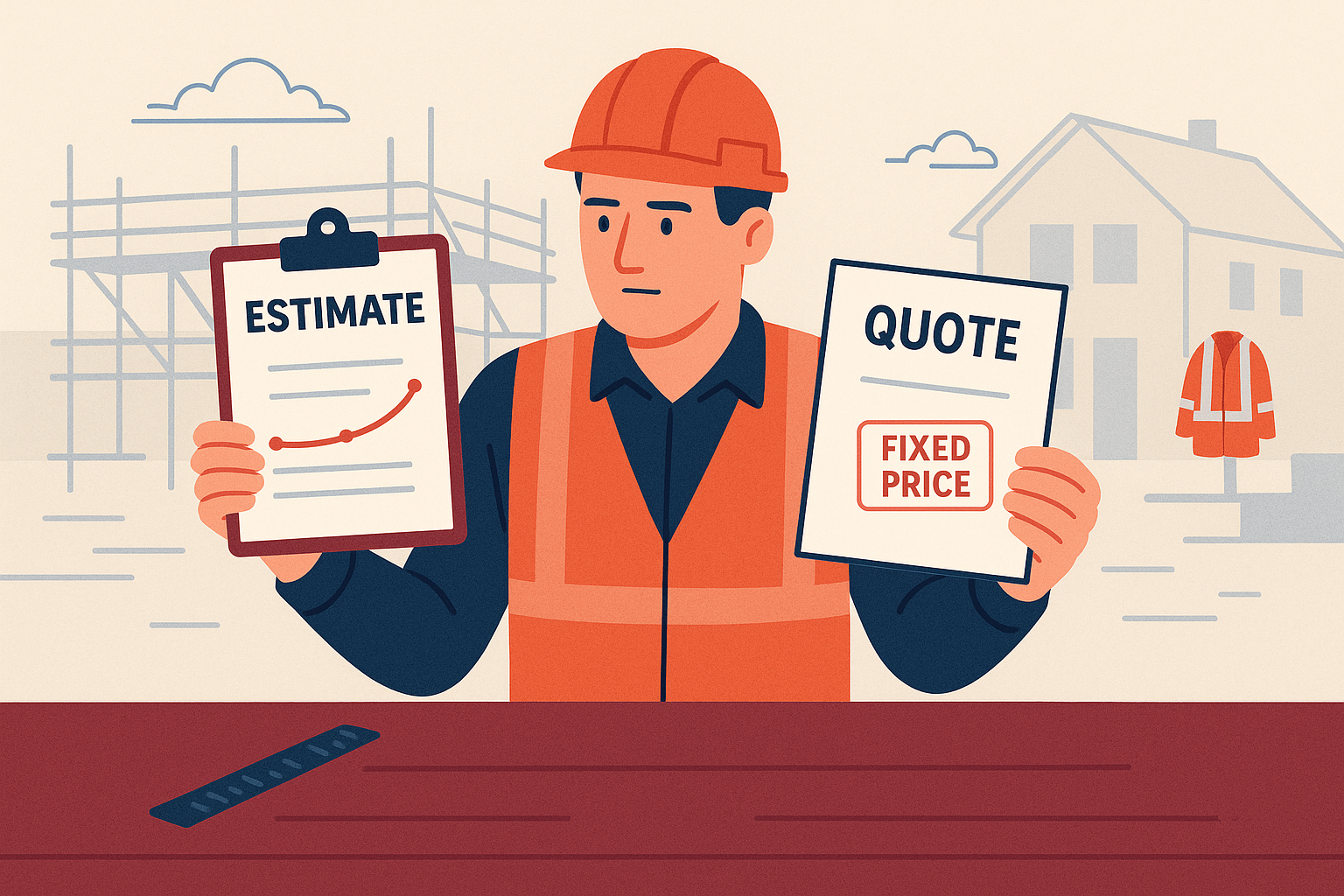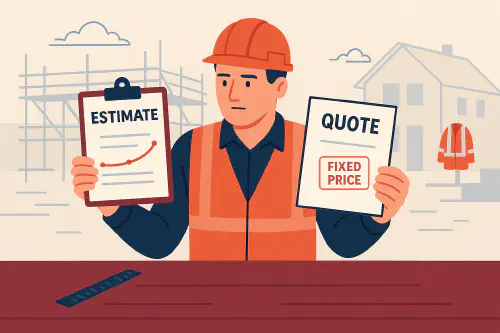
Estimate vs quote: what builders should send and how to avoid price disputes
Estimate vs quote: what builders should send and how to avoid price disputes
Contents
- Quick answer
- When to send an estimate vs a quote
- What to include in each document
- Pricing workflow that protects your margin
- Clauses you can copy
- Digital add-ons to speed up quoting
- UK legal basics in plain English
- FAQs

Builder comparing Estimate vs Quote documents on a UK site
Quick answer
- An estimate is a best guess. It is not binding and can change when the scope changes or unknowns show up. Label it clearly as an Estimate with a validity period and the factors that could move the price.
- A quote is a fixed price for a defined scope. Once the customer accepts it, it becomes binding for that scope. Use quotes when you have done a proper survey and the spec is clear.
- In the UK, if you give a quote and the client accepts, they should pay that price for the work quoted. If you give an estimate, it must still be realistic and not misleading. See guidance from Trading Standards and Business Companion and NI Business Info for the difference between a quotation and an estimate: Business Companion pricing guidance, NI Business Info.
When to send an estimate vs a quote
Use an estimate when:
- The project is early stage and the customer needs a ballpark.
- There are unknowns you cannot inspect yet (hidden services, structural issues, asbestos risk, damp).
- Client has not chosen finishes or brands.
Use a quote when:
- You have surveyed the site and have drawings/specs.
- Scope, quantities and access are known.
- You can lock a fixed price for defined inclusions and exclusions.
Simple decision flow:
Enquiry → Do we have drawings/specs and access? → No → Send ESTIMATE (with assumptions)
→ Yes → Send QUOTE (fixed price, defined scope)
Tip: if you start with an estimate, move to a fixed quote before ordering materials or booking dates. Tie it to a simple contract and variation process.
What to include in each document
Estimate essentials
- Title it “Estimate,” include ref, date and validity (for example, 30 days).
- Summary of works in plain English.
- Assumptions: access, hours, parking, waste, power/water, lead times.
- Exclusions and items the client will provide.
- Allowances for unknown selections (for example, “Allowance £500 for taps and shower set”).
- Breakdown: labour, materials, plant/subcontract, VAT line, estimated total.
- Notes on what could change the price and how you will agree changes.
Quote essentials
- Title it “Quotation” or “Quote,” with ref, date and validity.
- Defined scope and specification. Reference drawings/specs and versions.
- Clear inclusions and exclusions (scaffolding, waste, making good, certification).
- Itemised price or a fixed sum for the defined scope, plus VAT if applicable.
- Start window, duration, payment milestones, deposits, retention if any.
- Variation process: how extras are requested, priced and approved before work.
Good references and checklists:
- Federation of Master Builders on quotes and what clients expect: FMB guide and Create winning quotes.
- Which? on hiring builders and comparing quotes: Which? Trusted Traders.
Pricing workflow that protects your margin
- Qualify fast
- Ask for photos, rough dimensions and a brief spec. If it is not your ideal job, decline politely.
- If it is a fit, send an estimate range to keep the lead warm. Then book a survey.
- Survey properly
- Check access, parking, storage, protection needed, and risks (asbestos, live services, damp, structural issues).
- Confirm selections or set allowances for undecided items.
- Build a clean price
- Labour hours × your loaded hourly rate (include holidays, NI, downtime).
- Materials at current supplier prices, add expected wastage.
- Plant, skips, scaffolding, certification and Building Control fees if relevant.
- Overheads and profit on top. Be clear whether you use margin or markup.
- Add a contingency line if the client insists on tight timelines or winter work.
- Present clearly
- Use a single PDF with inclusions and exclusions on one page and a simple acceptance box.
- Offer optional upgrades as separate line items.
- Lock changes
- No extras without a written variation price accepted by the client.
- Keep evidence with photos and a short note in your site diary. For a simple digital setup, see our Construction site diary template.
Clauses you can copy
Scope and variations
This price covers only the items listed under Inclusions. Any additional work or client-requested changes will be priced as a written Variation. No variation work will proceed without written acceptance.
Allowances
The following allowances are included: Bathroom brassware £500 inc VAT; Floor tiles £35/m² inc VAT; Lighting £400 inc VAT. Selections above these allowances will increase the final price by the difference plus any related labour and fixings.
Access and working hours
Price assumes weekday working 8am–4pm, clear access, parking on or near site, and power and water available. Additional costs may apply if these assumptions change.
Validity and price changes
This quote is valid for 30 days. If supplier prices change materially before order, we will notify you and agree any adjustment in writing before proceeding.
Payment schedule
Deposit 10% on acceptance to secure dates; 40% on start; 40% midway; 10% on completion and handover. Payment due within 7 days of invoice.
Digital add-ons to speed up quoting
- Turn site voice notes into draft quotes you can tidy up later: Turn voice notes into quotes.
- Reply fast on new enquiries and collect details over WhatsApp: Speed‑Quote Formula.
- Win more work with polite follow‑ups that do not nag: Follow up quotes that win.
- Keep supplier prices tidy and compare options quickly: Automate supplier quotes and POs with Xero.
UK legal basics in plain English
- Quotes are fixed prices for a defined scope. If the client accepts, that price should be honoured for that scope. Estimates are non‑binding guide prices but must be realistic and not misleading. See Trading Standards’ pricing guidance: Business Companion and NI Business Info on quotation vs estimate.
- If you make pre‑contract statements about price or timescales, they can become binding terms the customer relied on (Consumer Rights Act 2015, s50). If no price is agreed, only a “reasonable” price is payable (s51). Read the Act on legislation.gov.uk.
- When you invite a consumer to buy, you must show the total price including taxes, or if it cannot be calculated in advance, explain how it will be calculated (Consumer Contracts rules and Trading Standards pricing guidance). See CMA/Business Companion guidance and CMA unfair practices.
Watch: pricing mindset from UK pros
- Quoting Jobs and Price Conditioning by Skill Builder.
FAQs
Is an estimate the same as a quote?
No. An estimate is a non‑binding guide; a quote is a fixed price for a defined scope once accepted. Useful reading: NI Business Info and Business Companion.
Should I give an estimate or a quote first?
If scope is unclear, start with an estimate range to qualify the job, then survey and issue a fixed quote. Do not order materials or book dates until a quote is accepted.
What makes a quote legally binding?
Acceptance by the client. Keep the scope, inclusions/exclusions and payment terms in writing. Pre‑contract statements can become binding terms (Consumer Rights Act 2015, s50).
Can I change the price after I quote?
Only if the client accepts a written variation for extra scope, or your contract allows for specific price adjustments (for example, unusual supplier increases) and you have stated that up front. Never proceed on verbal changes; get a quick written yes.